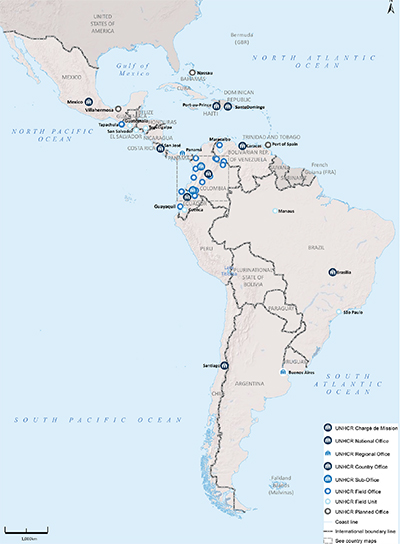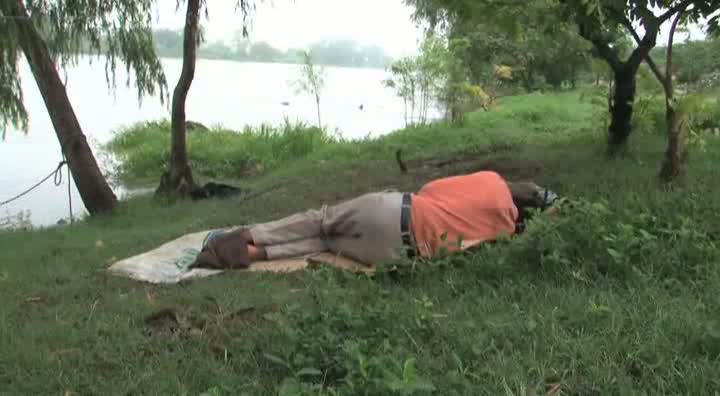Home > Where We Work > Americas > Latin America > Mexico
2015 UNHCR subregional operations profile - Latin America
| Overview |
During 2014, all States in the subregion participated in the Cartagena+30 process. MERCOSUR countries have renewed their commitment to high protection standards, the gradual and regional harmonization of procedures and practices, and proposed new solutions initiatives. This includes an evaluation of the Solidarity Resettlement Programme launched under the Mexico Plan of Action, with a view to improving and consolidating it. Particular attention and consideration has been given to the regional migration frameworks under MERCOSUR for the benefit of refugees, particularly regarding transnational labour mobility. Countries in South America, mainly Brazil and Argentina, have witnessed a notable increase in asylum-seekers in the region, particularly Syrians.
The humanitarian response to the protection needs of Guatemalans, Hondurans and Salvadorans - particularly unaccompanied children, adolescents and women who often suffer violence from transnational organized criminal groups - has featured prominently in discussions with governments and civil society partners. The number of people requiring protection has risen significantly. Of particular concern is the situation of unaccompanied children, who are exposed to various forms of abuse during displacement.
| Response and implementation |
The Declaration and Plan of Action of Cartagena+30, expected to be adopted in December 2014, will focus on the following regional priorities:
-
Harmonization of legislation, procedures and best practices at subregional level, within the frameworks of the respective regional integration mechanisms;
-
Expansion of the Quality Assurance Initiative (QAI) programme, to additional countries, to improve the management of asylum systems in the region;
-
Adherence to international and regional protection standards, including extraterritorial recognition of refugee status, elimination of administrative detention of asylum-seekers and children, special protection/ solution protocols for unaccompanied children seeking asylum, and specific protocols for lesbian, gay, bisexual, transgender and intersex individuals;
-
In the context of mixed migration movements, ensure protection safeguards at sensitive borders and strengthen regional cooperation and information sharing to combat and prevent human trafficking; enhance victims' protection; preserve the right to seek asylum; and establish mechanisms for the identification of protection needs and referrals;
-
Commitment to eradicating statelessness by 2024; acceding to and ratifying the UN's Statelessness Conventions; and enacting implementation procedures;
-
Enhanced international cooperation in search of solutions, in particular tripartite mechanisms for voluntary repatriation in the Andean region;
-
Promotion of local integration through: sensitization campaigns addressed at local authorities and communities; refugee and civil-society participation in the design of public policies; enhanced access to employment, with the support of private-sector social responsibility schemes, as well as to public services available to nationals; speedy and free personal documentation, without reference to the refugee status of the holder; a change of migratory status to obtain a permanent residence, and facilities for naturalization;
-
Consolidation of resettlement programmes within a comprehensive approach to solutions.
UNHCR's operation in Colombia is described in a separate chapter. For other countries where UNHCR operates in the subregion, please see below.
The Argentina Regional Office covers Argentina, as well as Bolivia, Chile, Paraguay, Peru and Uruguay. UNHCR's overall goal is to preserve and further enhance protection space in the region. To achieve this, its strategy will include the parallel implementation of programmes focusing on the legal and physical protection of people of concern, including statelessness; as well as public awareness and durable solutions.
The Office will continue working to expand the network of partners, by finalizing a livelihoods strategy in all six countries, to widen options available to achieve self-reliance and boost local integration opportunities.
In Chile and Uruguay, the Office will promote the continuation of the resettlement and the women-at-risk programmes, with greater involvement of the authorities in funding and implementation.
In Brazil, UNHCR is supporting the pledges made by the Government, particularly for the approval of a statelessness bill; and engaging with key state actors to increase government involvement in local integration matters, such as advancing self-reliance and livelihood options in urban areas. The Office is also working with the Government to strengthen its support to the solidarity resettlement programme; and to provide physical and legal protection for people of concern, particularly vulnerable individuals.
UNHCR in Costa Rica will continue re-orientating its protection and durable solutions strategy, including by maintaining regular visits to, and training activities, at the southern border points; and closely monitoring international airports and the northern border entry points for Central Americans requiring protection. The Office will capitalize on the QAI process developed in 2013, strategically applying limited human, technical and material resources to reduce the refugee status determination backlog, and improve recognition rates. UNHCR will concentrate on durable solutions, particularly local integration and job placement, strengthening alliances with the private sector built in 2013.
In Ecuador, the majority of refugees are interested in local integration, while a significant percentage is interested in resettlement in a third country. The Office will support government efforts to reach durable solutions; and advocate the right to work, social security, health and education. UNHCR will focus on access to resettlement, local integration, including alternative migratory solutions and voluntary repatriation with the goals of re-opening protection space and enhancing livelihood opportunities for refugees. The right to asylum and the fight against discrimination remain essential cross-cutting advocacy and communication goals.
Within the challenging environment in the northern triangle of Central America and the repercussions in Mexico, UNHCR plays a critical role to ensure international protection. The goal for the Office is to keep the door open for asylum, ensuring that asylum-seekers, both from within the continent (principally, from Central America), as well as other refugees mainly from Africa, the Middle East and Asia, are able to access the territory. The Office will work to ensure that people of concern area identified within migratory flows, informed about their rights, and have access to fair and efficient asylum procedures. Major protection challenges include the risk of human trafficking, special protection needs of unaccompanied children, alternatives to detention and the legal status of stateless people.
UNHCR's regional office in Panama, which covers Central America and Cuba, faces a shift in displacement trends caused by transnational organized crime in Central America.
While the number of asylum claims from other continents has decreased, there is a sharp increase in the numbers of people of concern from Central American countries. Particular efforts will be made to enhance asylum systems and the quality of protection afforded to those in need, and to promote the adoption of protection-sensitive policies on mixed migration movements. To achieve durable solutions for refugees, the Office will focus on the needs of the most vulnerable. UNHCR will work with all the UN agencies at regional level and with UN Country Teams in order to enhance international protection of asylum-seekers and refugees escaping transnational organized crime, and to raise awareness about new displacement patterns due to transnational organized crime.
UNHCR will provide technical support to concerned Governments in assessing displacement trends in El Salvador, Guatemala and Honduras.
Despite reparation and land restitution developments in Colombia, refugees continue to cross into the Bolivarian Republic of Venezuela regularly. UNHCR's main objective is to increase their access to effective and fair government-managed asylum procedures, including by expanding outreach capacity and increasing the effectiveness of national registration processes.
| Financial information |
UNHCR's operational budget for the Americas has remained relatively stable during the last five years. In 2015, increased needs are determined by the new regional initiative for the protection of forcibly displaced populations in Central America and Mexico, with financial requirements for the subregion standing at USD 95.3 million.
| UNHCR 2015 budgets for Latin America (USD) | |||||
|---|---|---|---|---|---|
| Operation | 2014 Revised budget (as of 30 June 2014) |
2015 | |||
| Refugee programme PILLAR 1 |
Stateless programme PILLAR 2 |
IDP projects PILLAR 4 |
Total | ||
| Total | 90,199,086 | 64,144,918 | 810,726 | 30,360,765 | 95,316,409 |
| 1. Includes activities in the Plurinational State of Bolivia, Chile, Paraguay, Peru and Uruguay. 2. Includes the Regional Legal Unit in Costa Rica. 3. Regional activities cover the entire Americas region. |
|||||
| Argentina Regional Office[1] | 4,304,636 | 4,696,038 | 73,035 | 0 | 4,769,073 |
| Brazil | 8,197,880 | 6,913,141 | 185,717 | 0 | 7,098,857 |
| Colombia | 30,540,097 | 1,289,231 | 0 | 30,360,765 | 31,649,996 |
| Costa Rica | 2,885,871 | 3,134,757 | 0 | 0 | 3,134,757 |
| Ecuador | 21,010,276 | 22,514,110 | 0 | 0 | 22,514,110 |
| Mexico | 2,943,463 | 4,088,576 | 0 | 0 | 4,088,576 |
| Panama Regional Office[2] | 8,429,731 | 9,627,586 | 551,975 | 0 | 10,179,561 |
| Venezuela (Bolivarian Republic of) | 10,950,133 | 10,950,134 | 0 | 0 | 10,950,134 |
| Regional Activities[3] | 937,000 | 931,345 | 0 | 0 | 931,345 |
Source: UNHCR Global Appeal 2015 Update
UNHCR contact information
| The UNHCR Representation in Mexico | |||||||||||||||
|---|---|---|---|---|---|---|---|---|---|---|---|---|---|---|---|
| Style of Address | The UNHCR Representative in Mexico | ||||||||||||||
| Street Address | Cervantes Saavedra 193, Oficina 1402, Col. Granada, Mexico D.F., 11520 Mexico, Mexico | ||||||||||||||
| Mailing Address | Cervantes Saavedra 193, Oficina 1402, Col. Granada, Mexico D.F., 11520 Mexico, Mexico | ||||||||||||||
| Telephone | 52 55 50 83 17 10 | ||||||||||||||
| Website | http://www.acnur.org | ||||||||||||||
| mexme@unhcr.org | |||||||||||||||
| Time Zone | GMT + -6 | ||||||||||||||
| Working Hours |
|
||||||||||||||
| Public Holidays | 01 January 2015, Ano Nuevo 02 February 2015, Mexican Constitution 02 April 2015, Jueves Santo 03 April 2015, Viernes Santo 01 May 2015, Dia del Trabajo 17 July 2015, Eid Al-Fitr 16 September 2015, Independence Day 23 September 2015, Eid Al-Adha 16 November 2015, Recolucion mexicana 25 December 2015, Christmas Day |
||||||||||||||
| The UNHCR Field Office in Tapachula | |||||||||||||||
|---|---|---|---|---|---|---|---|---|---|---|---|---|---|---|---|
| Style of Address | The UNHCR Field Office in Tapachula | ||||||||||||||
| Street Address | 21 Oriente No. 22 entre 9a y 11a Av Norte, Col. Lomas del Soconusco, CP 30725 Tapachula, Chiapas, Tapachula, CHPS, Mexico | ||||||||||||||
| Mailing Address | Prolongacion Central Oriente s/n, Plaza Kamico, local 5 y 6, Tapachula, CHPS, Mexico | ||||||||||||||
| Telephone | 52 962 642 5198 | ||||||||||||||
| Facsimile | 52 962 642 5200 | ||||||||||||||
| Website | http://www.unhcr.org | ||||||||||||||
| MEXTA@UNHCR.ORG | |||||||||||||||
| Time Zone | GMT + 3 | ||||||||||||||
| Working Hours |
|
||||||||||||||
| Comments | Mexican States: Chiapas, Tabasco, Oaxaca and Veracruz | ||||||||||||||




